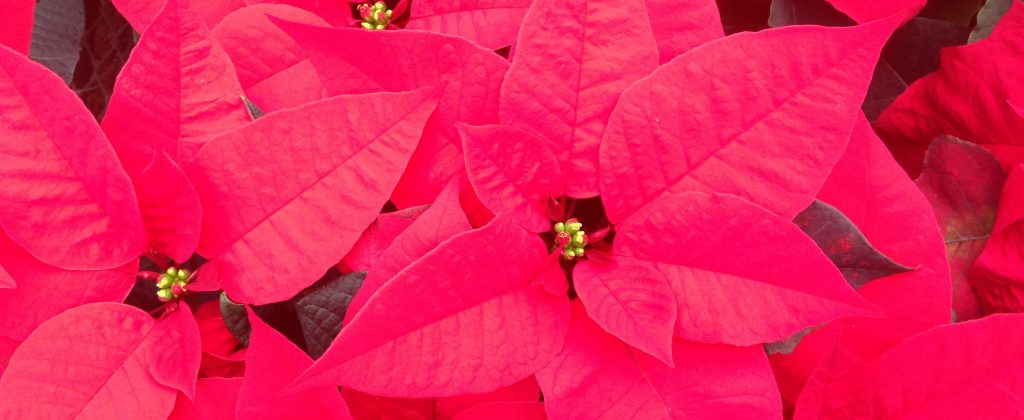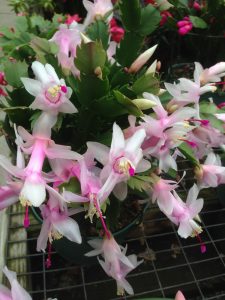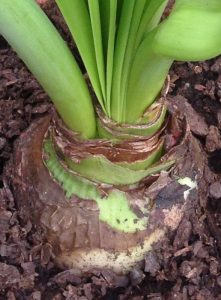By the time December rolls around, many gardeners are already starting to feel a void now that their gardens have gone to sleep. Luckily, there is a dazzling array of winter flowering plants that are available at this time of year – each guaranteed to wake up indoor landscapes and lift the spirits of any furloughed gardener.
From garden centers to big box stores to grocery stores — winter blooming plants seem to be everywhere in December. But not all offerings are equal. Since most winter flowers have been brought into bloom under tropical conditions closer to their native habitats, plants that didn’t receive the best of care along the way won’t last as long as those that were treated more protectively.
When buying winter flowering plants, keep the following in mind:
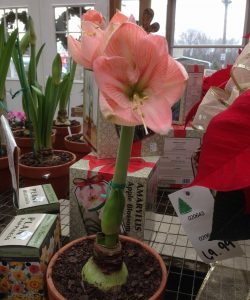
Examine holiday plants before purchasing. Well cared for specimens will last longer and bloom better.
- Look for healthy, robust, insect-free plants.
- To keep plants flowering for the maximum amount of time, be sure to pick out a plant with a few buds that are still closed or are just starting to open. If a plant is fully bloomed out when you first pick it up, there won’t be any buds left to sustain future flowering. While still beautiful, expect bloom times for these plants to be shorter.
- When transporting plants on cold days, be sure to protect them from the weather. Make sure plants are shielded with plastic or paper plant sleeves or paper bags. Tropical winter bloomers are subject to chilling injury when hit with temperatures much below 60°F.
- Avoid carrying them outside for any longer than the quick trip from the store to the car. And never leave plants in the car or trunk for any length of time in cold weather.
- One you’ve gotten your plants home, unwrap them right away and be sure to keep them out of the chilly path of opening doors or from touching frozen windowpanes. Plants kept in drafty areas may experience early leaf drop. Equally important is shielding them from heat as well as cold. So keep plants away from fireplaces, appliances, radiators, and ventilation ducts too.
For maximum bloom time, many winter flowering plants do best with cooler night temperatures. You can either move your plants to a cooler spot at night (like away from leaky windows) or turn down room temps at night (and save some energy to boot!) A drop of only 5 degrees –from a daytime 70°F to a somewhat brisker 65°F at night– has been shown to extend flowering time.
Florally Festive: Holiday Poinsettias
December’s most recognizable flowering plant would have to be the poinsettia (Euphorbia pulcherrima). A surefire source of vibrant indoor color, this true Christmas plant now comes in hundreds of different varieties.
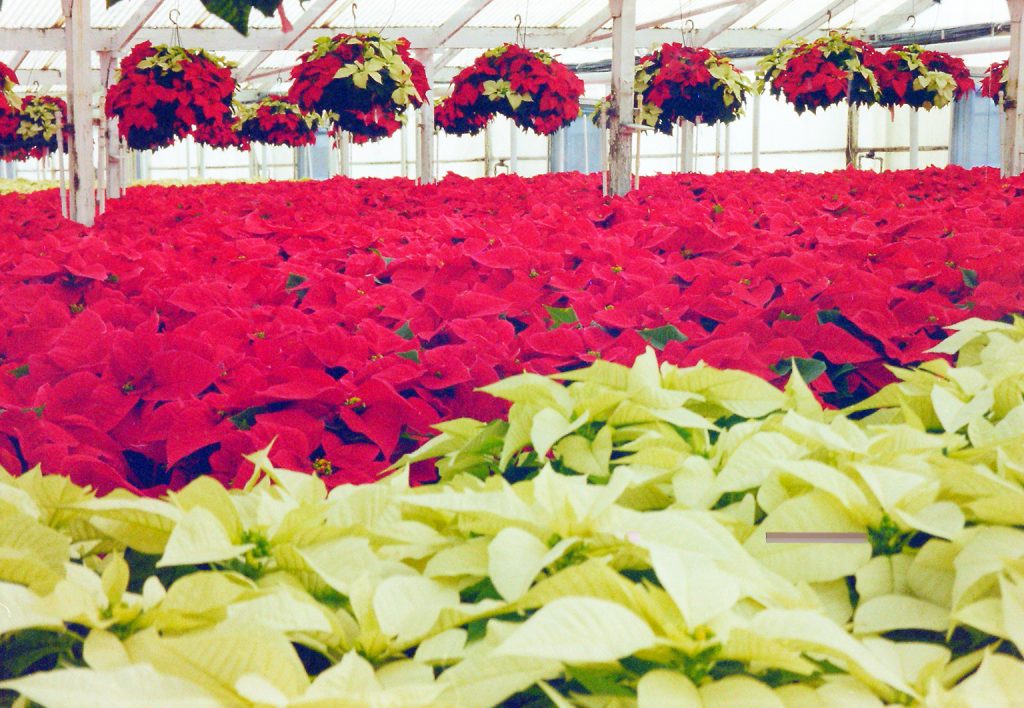
Poinsettias are very sensitive to hot or cold drafts. Even a brief zap of cold are can cause the leaves to drop prematurely. (Photo by Linda Park)
Aside from the ever-popular red, colors now include burgundy, pink, salmon, yellow, cream, and white; as well as speckled and marbled varieties. And plant breeders continue to develop spectacular new varieties every year. (To see some of this year’s new introductions take a peek inside Rutgers Floriculture Greenhouse: Poinsettia’s Fill Rutgers Floriculture Greenhouse)
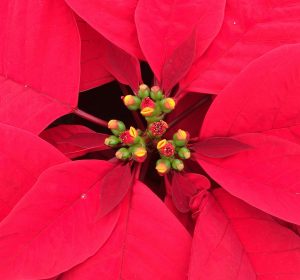
The showy, colored parts of poinsettias are not actually “flowers” but are in fact modified leaves or “bracts.” The true flowers, are the little yellow centers of the plant. (Photo by Linda Park)
Care and Feeding: A Poinsettia Primer
If cared for properly, poinsettias will hold on to their cheerful beauty for at least 3 months. Here are a few poinsettia pointers:
Light: Poinsettias prefer 4 hours of direct sun daily. Once in bloom, they tolerate bright, indirect light.
Temperature: At night: 50-60°F. During the day: 65°F and up.
Water: Poinsettias need to be kept consistently moist –which means soil should not allowed to become too soggy or too parched. Never allow soil to dry out completely but it’s OK to allow the surface to of the soil to dry a little before giving them a thorough watering. Never leave poinsettias in standing in water, leaves can rapidly yellow and drop.
Soil: A lightweight, peaty mix.
Fertilizer: No need to feed plants if you plan to discard them after they finish blooming. But if you’re planning to keep your poinsettia as a houseplant afterward, feed it monthly with an all-purpose house plant fertilizer.
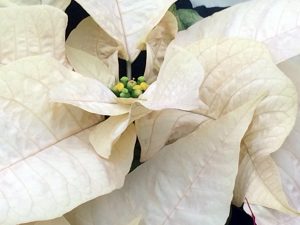
Since most poinsettias come in a plastic pot a good way to judge when they need water is to use the weight of the pot as an indicator: A well-watered pot will be noticeably heavier than one that is too dry. (Photo by Linda Park)
Are they “poison”–settias?
There has been much discrepancy surrounding the toxicity of poinsettias. For many years, they were considered to be “poisonous” plants. But over the years, studies have shown that no deaths or serious injuries have been attributed to poinsettia ingestion. That said, poinsettias–like numerous ornamental plants– are not intended for human consumption and swallowing the leaves can cause vomiting and diarrhea. Best to use commons sense and steer kids and pets away from houseplants in general. For more information on the toxicity of houseplants, including poinsettias, refer to the Rutgers Harmful Plants Gallery.
Getting Poinsettias to Rebloom
Among the most frequently asked questions regarding poinsettias is: “Can I get them to bloom again next year?” The short answer is yes. If you want to keep the plant for next year, maintain the poinsettia as you would any other houseplant throughout the winter: give it good light, regular watering and a monthly treatment of fertilizer. In very early spring, cut it back by about 2/3 to promote bushy new growth. Then either grow as houseplant or move it outdoors during the summer.
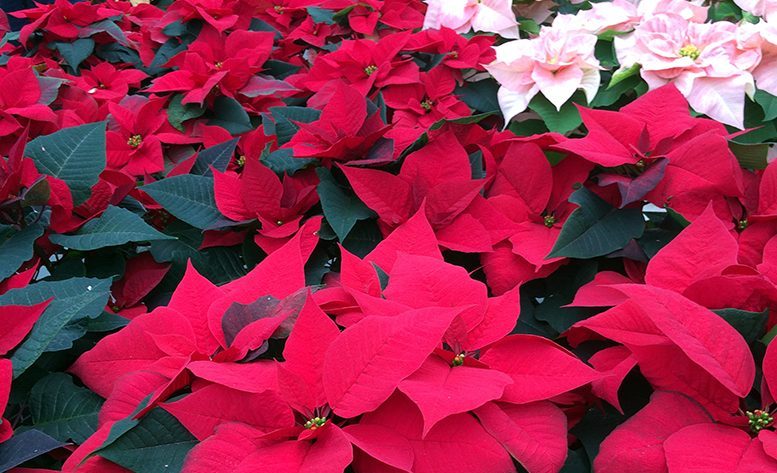
Although maintaining poinsettias through a second season can be done, most people tend to discard or compost them after the holidays and start with fresh plants the following year. (Photo by Margaret Montplaisir)
Poinsettias are photoperiod (day-length) dependent, so in order to recolor the following winter, they need a period of long (about 14-hour) nights to trigger color development in the bracts. So starting in mid-September, bring plants inside and put them in a room where no lights will be turned on at night, that –combined with naturally decreasing daylight during the fall –should be enough to promote good holiday color the following year.
Cascading Tubes of Color: Holiday Cacti
Although normally quiet, mild-mannered plants, a holiday cactus can really make a splash once the weather turns cold—offering floods of 3-inch, tubular flowers in saturated shades of red, fuchsia, pink, salmon and white.
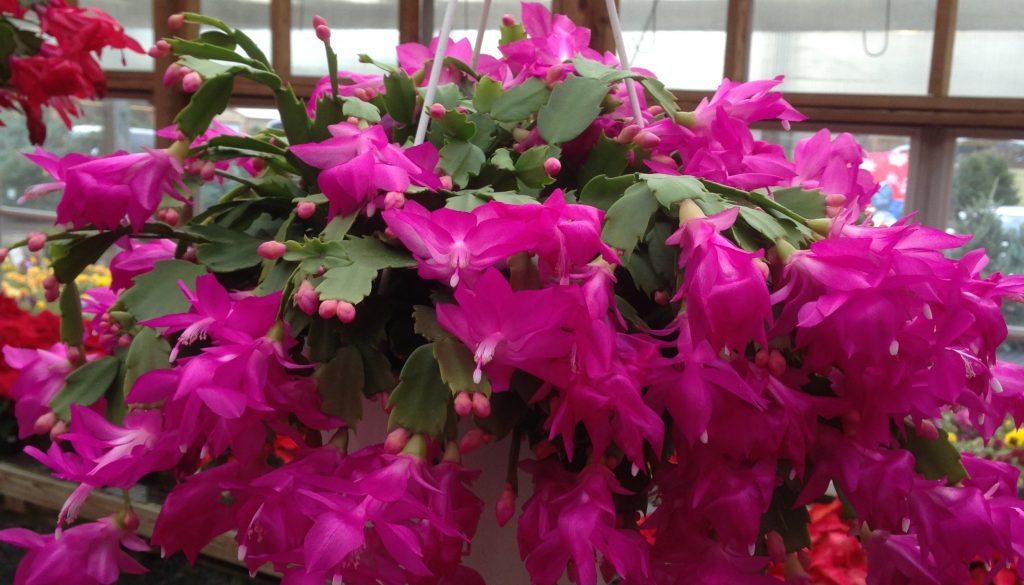
Holiday cacti come in a dazzling array of colors. They are easy to care for and often very long lived. Whether Christmas, Thanksgiving, or Easter cacti, these winter bloomers are among the few holiday plants suitable for growing all year long.
Although often referred to simply as a “Christmas cactus,” the fall- and winter-blooming succulent you see on the shelf could actually be one of three different types of holiday cacti: Thanksgiving cactus (Schlumbergera truncata) Christmas cactus (Schlumbergera bridgesii) or Easter cactus (Rhipsalidopsis gaertneri.)
What’s the difference?
- Christmas cacti have flattened leaves with rounded teeth
- Thanksgiving cacti have pointed teeth
- Easter cacti have pointed teeth with fibrous hairs in the leaf joints
Under normal conditions, each type will bloom closest to the holiday suggested in its name. And while they generally thrive under similar growing conditions, Thanksgiving and Christmas cacti need short day lengths and cool temperatures to set their flower buds, while Easter cacti will bloom just fine during normal length days.
Going with the Flow: Flowering Cactus Care
Here’s what you need to know to keep the cactus color coming:
Light: Keep your cactus in bright indirect or curtain filtered sunlight. Full sun is acceptable from September to May inside, but be sure to place plants in partial shade if you put them outdoors in summer.
Temperature: At night: 60°-65°F (unless setting buds, then 55°F or lower at night.) During the day: 70°F and up.
Water: Although a member of the cactus family, a holiday cactus should not be kept dry like its relatives. It is especially important not to let soil dry out too much during flowering. Keep plants evenly moist while budded and blooming, but allow it to dry out between watering during its “rest period” between bloom times. Water only enough to keep stems from shriveling while buds are setting in fall.
Soil: Equal parts potting soil, peat, and coarse sand or vermiculite or an African violet mix.
Fertilizer: Apply monthly from March to November. Do not fertilize while resting.
Figuring out Flower Failure
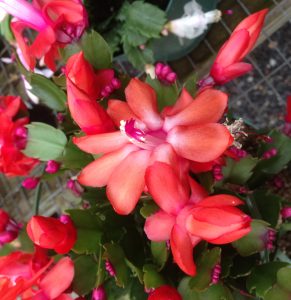
Although a member of the cactus family, a holiday cactus should not be kept dry like its relatives but should be watered whenever the top inch or so of soil is dry to the touch.
A somewhat common but highly disappointing problem is the tendency of holiday cacti to drop unopened flower buds. Possible causes include:
- Allowing the plant to dry out
- Soil that is compacted or poorly drained
- Low light
- Low humidity
- Drafts or other sudden changes in temperature
- A change in the way the plant is facing (a change in its orientation to light)
The most common disease of holiday cacti is stem and root rot, in which plants appear wilted and dull gray-green; stem leaves may also fall off. The best way to prevent your cactus from succumbing is to avoid over watering.
Keep it Growing: Supporting Next Year’s Flowers
Holiday cacti are not demanding plants, and pretty much “thrive on neglect,” which may be partly responsible for their reputation as long-lived plants. To ensure they bloom around Thanksgiving or Christmas next year, keep plants evenly moist and fertilize monthly with a 15-30-15 houseplant fertilizer during the growing season. In late spring, move them outdoors to a partly shaded location. In the fall, when frost threatens, bring them back indoors. Since day length and temperature regulate the flowering of Christmas and Thanksgiving cacti (Easter cactus does not need a cool winter rest period) keep them in a cool room during the fall (below 70°F) where they will receive no artificial light (too much light and too high a temperature at this time will prevent buds from forming.) Once buds are set, keep night temperature between 60-70°F and day temps around 70°F.
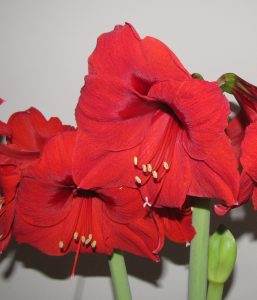
Amaryllis require some care and attention throughout the year, but those beautiful trumpet shaped flowers are a great reward in the long months of winter. (Photo by Theodora Wang)
Brilliance from Bulbs: Growing Amaryllis
The tall trumpeted flowers of amaryllis (Hippeastrum) are truly regal and their ability to burst into bloom in mid- winter make them a natural for banishing winter blahs. Flowering on 1 to 2 foot stalks (scapes) amaryllis produce giant, 6 to 10-inch trumpet-shaped flowers. Although red and scarlet are the most popular colors, flowers may be pink, white, salmon, apricot, rose, bicolor or picotee (petals with a different edge color) and come in both single and double varieties.
Bring on the Bloom: Amaryllis Care
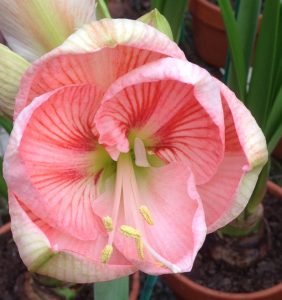
When grown indoors, bulbs will bloom in about 8 weeks. After they go dormant, they can be brought out every winter to bloom again.
Amaryllis can be purchased as bulbs or plants, in or near bloom. If purchasing bulbs, be sure to leave 1/2 of the bulb above soil when potting. Bulbs should bloom about 1 month after planting. Once the large bud emerges from the bulb, here’s what they need to flourish:
Light: Bright, direct light: East, west or south window.
Temperature: At night: 55-60°F. During the day: up to 75°F.
Soil: All-purpose mix.
Water: Keep evenly moist from November to August, then let dry for at least a month or two until the foliage yellows and dies. Resume watering after a dormant period of 2-3 months.
Fertilizer: Feed monthly from January to August with an all-purpose houseplant fertilizer.
Post Bloom Care
To ensure years of repeat blooms, keep the plants actively growing after they have finished flowering. Once the flower fades, cut back the flower stalk to about two inches above bulb. Then keep the plant moist and fertilized throughout the winter. Allow it to dry down between watering to prevent root and bulb rot.
If desired, plants can be moved to a bright location outdoors from May to August. At the end of the summer, let plants dry for at least a month or two until the foliage yellows and dies. Resume watering after a dormant period of 2-3 months (this dormant period is essential for bulbs to rebloom.)
Often the bulb will signal that it is coming out of dormancy by sending up the very tip of a flower stalk or leaf at the cut neck of the bulb. Then it’s time to place it back in a sunny window and resume watering.
Houseplants make great holiday gifts! Why not include some of our care instructions along with your present and keep both the gift plant and newly gifted recipient happy and healthy.
Grow a Winter Garden
Just because winter winds are howling outside, it doesn’t mean the pleasure of watching flowers break into bloom has to be put on pause until spring. The plants described here are just a few of the fiery florals that are available to warm up the cold, dark days ahead. So why not add a little flower power to your interior plantscapes this year?
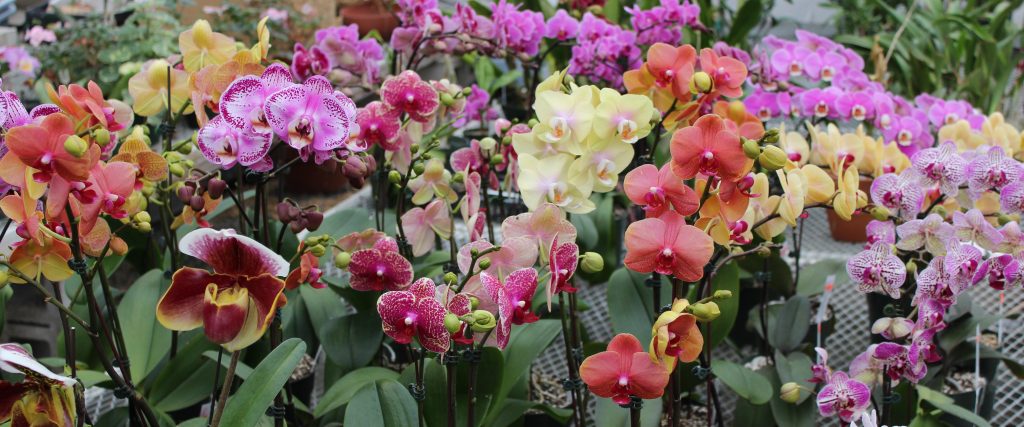
Poinsettia, Christmas cactus and amaryllis are just a few of the plants that offer spectacular indoor blooms. Consider the vivid hues offered by orchids (pictured above) or the softer shades of camillia, and violets . See our links below for more details. (Photo by Linda Park)
For more information on these and other winter flowers, see :
